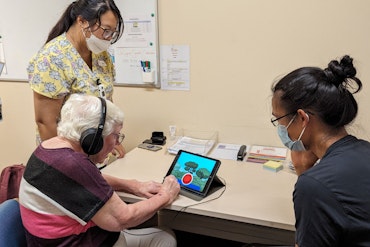Community Vision’s plea for technology in aged care

Community Vision, established in 2001, aims to support home, disability and family care in Perth through non-for-profit and community-based service. (Source: Shutterstock)
Key points:
- Aged Care Week (June 21 – 23, 2023) at Sydney’s International Convention Centre (ICC) is an opportunity for providers to convene and determine the future of aged care
- Chief Executive Officer (CEO) of Community Vision Yvonne Timson, shares her outlook on the role technology plays in day-to-day operations
- Attendees show their annual support for the conference in order to learn about compliance, financial sustainability and data usage
The fourth annual Aged Care Week conference is focused on ‘the future of aged care,’ with technology and digital frameworks at the forefront of progress within the industry.
Yvonne Timson, CEO of leading not-for-profit aged care services provider, Community Vision, shares her advice on how providers in the aged care sector must take advantage of new technologies during this time of reform, as they are constantly required to achieve more, despite working with less.
Yvonne’s talk addresses improvements to the use of data and technology, stating that the path forward is paved with public scrutiny and finding hope in strategic digital integration is key to ensure reforms bring meaningful change for the sector.
“It is vital that we leverage the latest in technology to drive better customer outcomes, bring more choice for customers, promote their independence and all the while assisting our business to operate at its peak,” she says.
“All these positive customer outcomes also lead, one way or another, to savings, so it makes good business sense to be harnessing technology and diving deep into the data it can provide [for] us.”
“At Community Vision, we have developed our own software technology for the community care space. The data we can generate keeps us compliant, tracks our financials and worker productivity, drives our efficiencies, and validates our business practices and this always keeps the customer at the forefront of everything we do.”
The CEO elaborates, providing examples of beneficial technology use for quality and safety protocols in aged care, such as: reporting of incidents or hazards with the case notes all in one place and without separate reporting; automated reports which are available to support quality indicators, assessment dates, billing lines or unpaid invoices.
“All these things are optimising scheduling, reducing travel, reducing overtime and agency use, whilst increasing skill matches and preferences for our customers. We are more efficient, with less administrative burden on our support workers,” Yvonne says.
“It also allows us to recognise exactly what each individual consumer wants. Customers are in control — driving their own better health and wellbeing outcomes, as we use the relevant data they provide to personalise their care plans. This can be anything from choosing a homemade meal to order online [sic], accessing their support team, reviewing their own accounts and appointments via their own customer portal, or simply seeing what Community Vision has to offer in terms of events and outings.”
Yvonne says that an integrated system delivers efficacy and highlights sluggish aspects that need improvement, in order to deliver person-centred care.
“Ultimately, I urge all businesses in the aged care and home care space to consider how they can drive customer-centricity through the improved use of data and technology. As our sector progresses and we weather the storm of reforms, we must be developing the infrastructure to leverage data and increase the independence of older Australians,” she concludes.
“We can utilise technology to relieve the administrative burden on the aged care workforce, enabling a higher focus on caring responsibilities as we work together with the Government on reform.”























